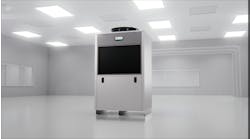Latest from Hydronics
Indirect vs. Direct Water Level Indicators Explained
Sponsored
We do things a certain way because we like the way it worked out the last time. If you like your US Prime steak cooked medium rare or medium well, you always order it that way, without even thinking about it. You like how it tastes, looks and chews.
We do things a certain way because we were trained to do it that way. If you learned your trade using a folding ruler, you may be getting strange looks from the young kids that learned how to use a laser ruler, like the kid learning from me. They have no idea how many ways a folding ruler can work.
The kid and I met at a job site recently, to advise a confused homeowner and get a heat loss calculation for a room being remodeled. The kid’s job was to get the measurements, so he got out his laser and ipad. Before I found out who was at home to consult with, he was done. The calculation process used to be pencil, paper and grade school arithmetic. Now it is keystrokes on a device.
The contractor wanted to take out an oversized steam boiler and put in a mod-con water boiler. There are good reasons to do this and some pitfalls to avoid. We had met there two days before to assess the idea. The house has a two pipe system that could be changed without too much trouble and the boiler looked to be three times the size required. Both good reasons to make a drastic change and no alarm bells were ringing regarding the transformation, but I did want to check the existing boiler size.
My old habit of sizing a steam boiler, based on the way I was trained, is to find every radiator in the building, hooked up or not. Once I have a list on my trusty legal pad, I calculate the square footage of equivalent direct radiation (EDR) of each radiator. I add it up, then add it up a second time to make sure. I don’t recall who insisted that I check my math, but that old habit isn’t changing since it’s caught a couple of my errors through the years.
Once I have the total EDR of the radiation, I look at boiler output ratings. There are two ratings. The higher one is the gross output, while the lower one is the net output. I was told from the beginning to make sure that the net EDR rating of the replacement boiler always exceeds the total that I always add up twice. “You need to fill the system with steam!”
But, through the years I thought that method would oversize certain jobs. I also thought I should use that method to cover my ass and keep my job. However, now I’m older, wiser and not so worried about my job. What I have learned about the net rating has caused me to lean more towards the gross output rating.
Boilers are more efficient when they are properly sized, so I have always tried to size correctly. In the olden days of coal fired boilers, the coal fire could go out overnight or after an extended absence. They were hands-on, shovel-your-own beasts, not connected to a fancy mobile phone app. Since the house could go cold between fires, a pick-up factor was part of the reason for using a net rating. Essentially it oversizes the boiler to quickly bring the house up to temperature from a cold start. This made perfectly good sense with coal fired equipment. But, when was the last time you saw a coal boiler in action, outside of Amish country?
The other reason for the net rating is unusual loss for piping in un-heated spaces. This absolutely has merit when it applies, like when steam mains run un-insulated through garages or crawl spaces. Bare pipe has a square foot of EDR rating so it can be calculated and added to the radiation load.
So when do I use the gross output rating rather than the traditional net rating? First, it has to be an automatic fired boiler that doesn’t experience deep, deep thermostat setbacks. Second, there can’t be any unexpected piping losses. Third, the gross output of the boiler and the output of the radiation have to exceed the heat loss of the house.
If you have 200,000 btu’s of radiation, but the heat loss is only 125,000 btu’s, you only need a boiler with a gross output of something more than 125,000 btu’s. Steam radiators do not have to be completely full of steam to heat a room. Perhaps they were originally oversized, or the heat loss was reduced because of added insulation, replacement windows, or room additions.
So how did the old timers size their radiators? You will find that most steam radiators were installed before there were accurate heat loss calculations available. They had their own old habits that worked for them, which probably oversized radiators to avoid any callbacks.
How should you size a steam replacement boiler? Find the radiation, calculate the total EDR, and have some kid quickly run a heat loss to help with the sizing process. Check with the homeowner about thermostat setback and/or steam pipes running uninsulated. Then make your selection based on heat loss if you want to change an old habit. You might find that you can use a smaller boiler than expected, or what’s being quoted by your competition. I found out this boiler was only twice the size needed.
The homeowner might tell you that he wants the same size that was there. I couldn’t convince my dad to downsize his boiler when it came time for him to replace. His was gravity hot water, and yes, it went back in as gravity hot water. No pump for my dad. Talk about old habits…
We try doing something a new way when we don’t like how the old way worked out, or is now longer an option, like a standing pilot on a gas appliance or a PCS motor on anything new. Government regulations and advanced technologies are constantly changing, therefore affecting how we do things. The only constant in the world is change. A Greek philosopher named Heraclitus said that 2,500 years ago, and he’s still right.
Patrick Linhardt is a thirty-five-year veteran of the wholesale side of the hydronic industry who has been designing and troubleshooting steam and hot water heating systems, pumps and controls on an almost daily basis. An educator and author, he is currently Hydronic Manager at the Corken Steel Products Co.
Patrick Linhardt
Patrick Linhardt is a forty-one-year veteran of the wholesale side of the hydronic industry who has been designing and troubleshooting steam and hot water heating systems, pumps and controls on an almost daily basis. An educator and author, he is currently Hydronic Manager at the Corken Steel Products Co.


